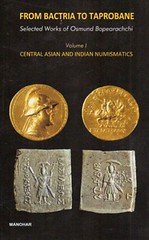
PREV ARTICLE
NEXT ARTICLE
FULL ISSUE
PREV FULL ISSUE
NEW BOOK: FROM BACTRIA TO TAPROBANE
Here's information on a new book on central Asian and Indian numismatics. -Editor
Authors (s): Osmund Bopearachchi (Author)
Overview for From Bactria to Taprobane: Selected Works of Osmund Bopearachchi (In 2 Volumes) Contents: Vol I: Central Asian and Indian Numismatics: Preface. 1. Pre-Bactrian Numismatics 2. Bactrian and Indo-Greek Numismatics. 3. Indo-Scythian, Indo-Parthian and Kushan Numismatics. 4. Cultural Heritage of Afghanistan. Index. The first volume comprises Osmund Bopearachchi’s most important articles on the numismatics of Central Asia and India, particularly of pre-Bactrian, Graeco-Bactrian, Indo-Greek, Indo-Parthian and Kushan Coins. There are 36 articles on numismatics and 3 on the destruction of Afghanistan’s cultural heritage during the period of Civil War. It is well known that from the time of Theodore Bayer, the reconstruction of the history of Greek settlers of Alexander the Great in Bactria and India and their nomadic successors, Scythians, Parthians and Kushans, has depended mainly on coins. It is only in the light of these coins that the rare ancient texts and the limited archaeological evidence can be used for writing their history. Since the publication of Bopearachchi’s first book, Monnaies Greco-bactriennes et indo-grecques, Catalogue raisonne (1991), nearly half a million coins have surfaced in Afghanistan and Pakistan as a result of accidental finds and illegal excavations. His research is mainly based on these new discoveries. Through his work he has brought to light new kings, coin types, monograms, overstrikes and coin hoards. Bopearachchi has also shown that the history of Greeks and their successors in Central Asia and India can no longer be written based solely on numismatics. He has taken into consideration other forms of human activities such as architecture, sculpture, epigraphy, ceramics and artefacts and shows it amply in his writings based on his own investigations and the contributions of eminent archaeologists, historians, numismatists, epigraphists and art historians of Central Asia and India. Vol II: Art History and Maritime Trade: Preface. 1. Central Asian and Indian art. 2. South Indian and Sri Lankan art. 3. Maritime trade in the Indian Ocean. Index. The second volume of Osmund Bopearachchi has articles and monographs on Central Asian and Indian art, South Indian and Sri Lankan art and finally maritime trade in the Indian Ocean. While documenting thousands of coins in the Pakistani markets from 1992 onwards. Bopearachchi realized that one has to go beyond the traditional approach of simply cataloguing coins, and as a result he has made an attempt to link numismatics with sculptural and pictorial iconography. His studies on Utpalavarna, the courtesan who later became a bhiksuni (Buddhist nun) and on the earliest iconography of Hindu gods like Siva, Brahma, Visnu and Varaha have revolutionised our knowledge of these domains. His writings giving the result of the archaeological excavations and explorations carried out by the department of archaeology and the French Archaeological Mission in Sri Lanka along the estuaries and rivers provide substantial evidence to indicate that in ancient times large ships could cast anchor in the sea close to river mouths and commodities were taken to inland markets using the rivers and waterways. His work also shows how the movements caused by these human activities have amalgamated local traditions with foreign identities and created new forms of art and belief. His research on sculptures imported to the island from Amaravati-Nagarjunakonda deals with the inspiration of these schools of art over the early forms of Buddhist sculpture in Sri Lanka. The different architectural aspects of the royal palace complex of Sigiriya, build by King Kassapa (477-95 CE) clearly demonstrate that various external ideas and concepts were used to convert this huge lofty rock into a more elaborate harmonious whole, in another words a paradise or an Alakmanda.
As noted in previous articles, sites like PrintAsia.com may be able to offer better deals for books published in India. -Editor
For more information, or to order, see:
Wayne Homren, Editor The Numismatic Bibliomania Society is a non-profit organization promoting numismatic literature. See our web site at coinbooks.org. To submit items for publication in The E-Sylum, write to the Editor at this address: whomren@gmail.com To subscribe go to: https://my.binhost.com/lists/listinfo/esylum All Rights Reserved. NBS Home Page Contact the NBS webmaster 
|
